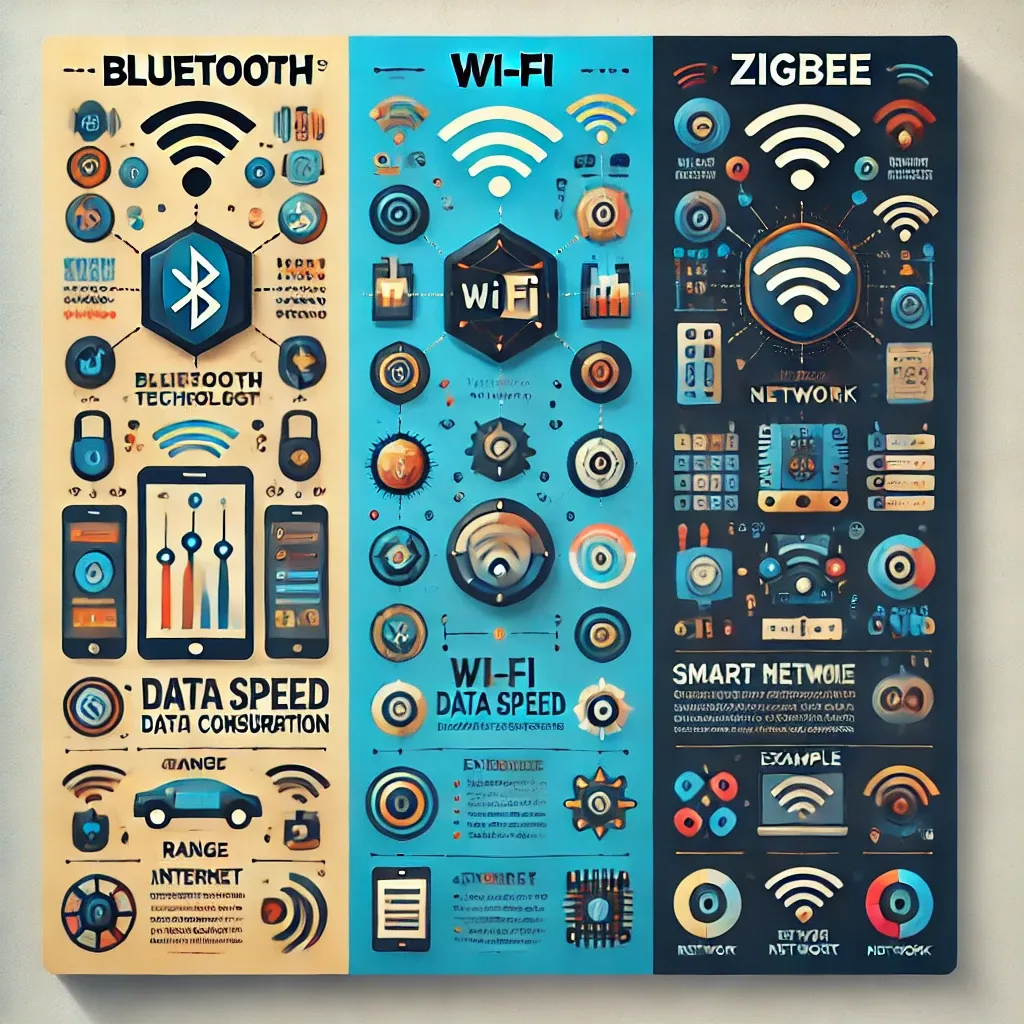A Comparison of Bluetooth, Wi-Fi, and Zigbee
Introduction
In today’s fast-paced world, wireless communication technologies have become an integral part of our daily lives. Whether in smart homes, wearable devices, or industrial applications, wireless connectivity plays a vital role. Among the most prominent technologies are Bluetooth, Wi-Fi, and Zigbee. But what are the key differences between them? And which one is best suited for your needs? In this article, we will provide an in-depth comparison of these technologies in terms of performance, power consumption, range, applications, and advantages.
1. Overview of Each Technology
1.1 Bluetooth
Bluetooth is a short-range wireless communication technology used for data transmission between devices such as smartphones, headphones, smartwatches, and more. First introduced in 1999, Bluetooth aims to provide reliable connectivity at a low cost.
1.2 Wi-Fi
Wi-Fi is a wireless communication technology that enables devices to connect to the internet or transfer data locally at high speeds. It was developed to offer longer-range and higher bandwidth compared to Bluetooth.
1.3 Zigbee
Zigbee is a low-power wireless communication technology designed primarily for Internet of Things (IoT) applications, such as smart home automation, sensors, and smart lighting. Launched in the early 2000s, Zigbee ensures stable connectivity with minimal power consumption.
2. Performance Comparison
2.1 Range
Bluetooth: Operates within a range of 10–30 meters under ideal conditions. Bluetooth 5.0 extends the range up to 240 meters in open spaces.
Wi-Fi: Offers a broader range of 30–50 meters indoors and up to 100 meters outdoors.
Zigbee: Covers a range of 10–100 meters, depending on the environment, and is primarily used in small spaces for smart home applications.
2.2 Data Transfer Speed
Bluetooth: Offers a data transfer speed of up to 2 Mbps (Bluetooth 5.0).
Wi-Fi: Provides high speeds ranging from 54 Mbps to over 1 Gbps in modern networks.
Zigbee: Has a lower speed of up to 250 Kbps, making it ideal for small and continuous data transmissions.
2.3 Power Consumption
Bluetooth: Features low power consumption, especially with Bluetooth Low Energy (BLE).
Wi-Fi: Consumes more power, making it less efficient for battery-powered devices.
Zigbee: Highly power-efficient, allowing devices to operate for years on a single battery.
3. Practical Applications
3.1 Bluetooth
Wearable devices such as smartwatches and headphones.
Data transfer between phones and computers.
In-car applications like phone-to-audio system connectivity.
3.2 Wi-Fi
Internet connectivity for household devices.
High-quality video streaming.
Online gaming.
Business applications such as virtual meetings.
3.3 Zigbee
Smart home automation, including lighting, blinds, and air conditioners.
Home security systems.
Industrial applications requiring stable connectivity and low power usage.
4. Pros and Cons of Each Technology
4.1 Bluetooth
Pros:
Low power consumption.
Cost-effective.
Simple and fast device pairing.
Cons:
Limited range.
Slower data transfer compared to Wi-Fi.
4.2 Wi-Fi
Pros:
Wide coverage and high speeds.
Ideal for internet and media streaming applications.
Supports multiple devices simultaneously.
Cons:
High power consumption.
Performance can be affected by network interference.
4.3 Zigbee
Pros:
Highly efficient power consumption.
Supports mesh networking for extended coverage.
Ideal for low-cost, low-power devices.
Cons:
Lower range and speed compared to Wi-Fi.
Requires a hub (gateway) for some devices.
5. Choosing the Right Technology
5.1 If You Need:
Fast and high-quality data transfer: Choose Wi-Fi.
Simple and short-range connectivity: Bluetooth is the best option.
Energy efficiency and long-term operation: Zigbee is the ideal choice.
5.2 Suitable Applications:
For smart homes: Zigbee is preferred due to its mesh networking and power efficiency.
For wearable devices: Bluetooth Low Energy (BLE) is the best fit.
For internet connectivity: Wi-Fi is ideal due to its speed and range.
Conclusion
Bluetooth, Wi-Fi, and Zigbee are not direct competitors but rather complementary technologies. Each has its strengths and weaknesses, making it suitable for different applications. When choosing a wireless solution, it is essential to consider range, speed, power consumption, and intended use. As these technologies continue to evolve, we can expect even more advanced and flexible solutions in the future.
Frequently Asked Questions
1. Which technology is best for smart homes?
Zigbee is the best choice as it is designed for IoT devices and has low power consumption.
2. Can Wi-Fi replace Zigbee?
It can, but Wi-Fi consumes more power and is less efficient in supporting mesh networks.
3. Does Bluetooth support long-range communication?
Newer versions like Bluetooth 5.0 support extended ranges up to 240 meters under ideal conditions.
4. Which technology is best for industrial applications?
Zigbee is preferable due to its stability and power efficiency.
5. Can these technologies work together?
Yes, they can be integrated into multi-protocol systems to provide seamless connectivity for different applications.

